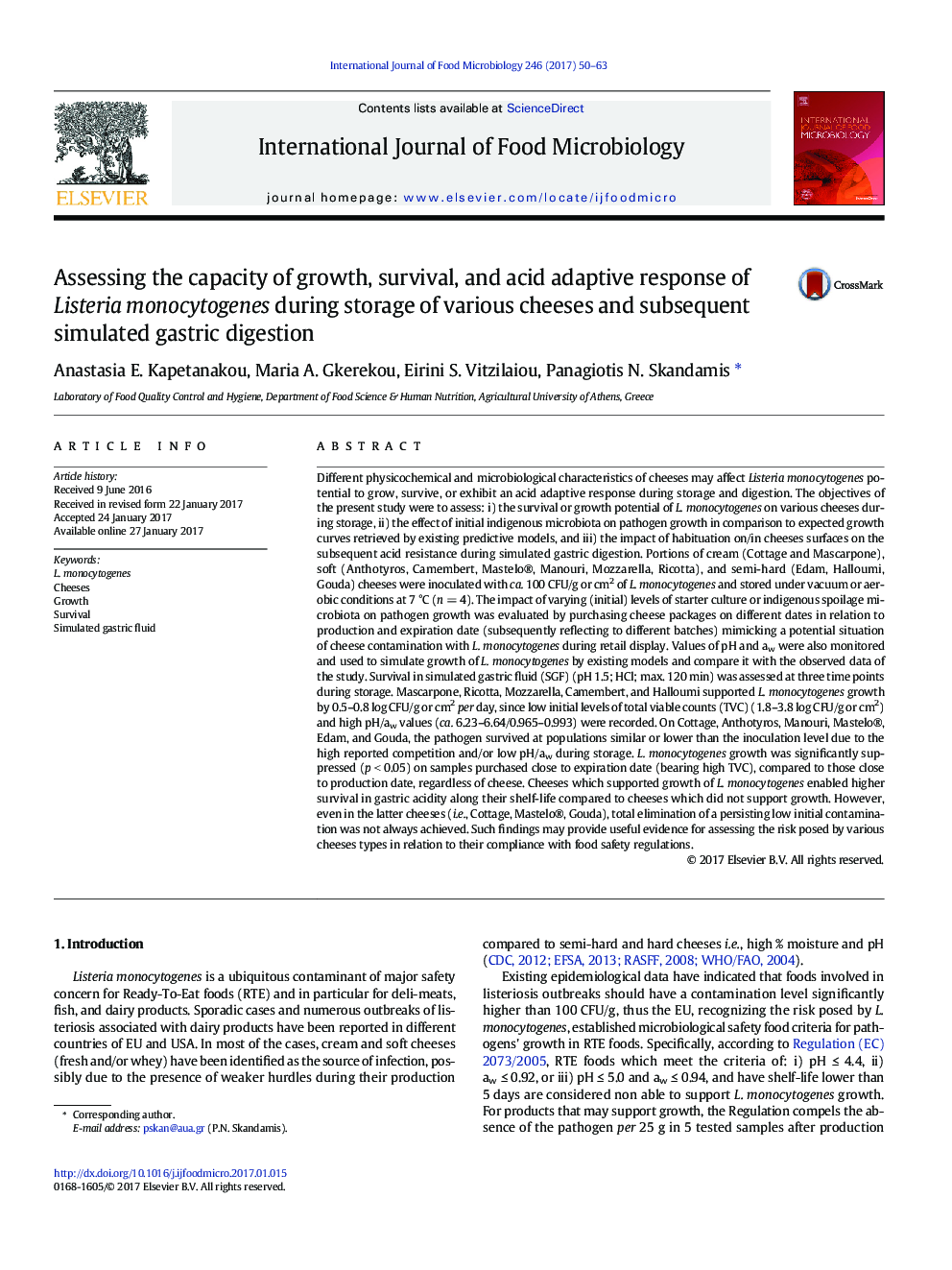| کد مقاله | کد نشریه | سال انتشار | مقاله انگلیسی | نسخه تمام متن |
|---|---|---|---|---|
| 5740855 | 1616537 | 2017 | 14 صفحه PDF | دانلود رایگان |
- Increase of indigenous microbiota on cheeses suppressed pathogens' growth at 7 °C.
- ComBase and GroPIN predicted satisfactory the growth of pathogen on the tested cheeses.
- Cheeses-supporting pathogens' growth showed high resistance after SGF along their shelf-life.
Different physicochemical and microbiological characteristics of cheeses may affect Listeria monocytogenes potential to grow, survive, or exhibit an acid adaptive response during storage and digestion. The objectives of the present study were to assess: i) the survival or growth potential of L. monocytogenes on various cheeses during storage, ii) the effect of initial indigenous microbiota on pathogen growth in comparison to expected growth curves retrieved by existing predictive models, and iii) the impact of habituation on/in cheeses surfaces on the subsequent acid resistance during simulated gastric digestion. Portions of cream (Cottage and Mascarpone), soft (Anthotyros, Camembert, Mastelo®, Manouri, Mozzarella, Ricotta), and semi-hard (Edam, Halloumi, Gouda) cheeses were inoculated with ca. 100 CFU/g or cm2 of L. monocytogenes and stored under vacuum or aerobic conditions at 7 °C (n = 4). The impact of varying (initial) levels of starter culture or indigenous spoilage microbiota on pathogen growth was evaluated by purchasing cheese packages on different dates in relation to production and expiration date (subsequently reflecting to different batches) mimicking a potential situation of cheese contamination with L. monocytogenes during retail display. Values of pH and aw were also monitored and used to simulate growth of L. monocytogenes by existing models and compare it with the observed data of the study. Survival in simulated gastric fluid (SGF) (pH 1.5; HCl; max. 120 min) was assessed at three time points during storage. Mascarpone, Ricotta, Mozzarella, Camembert, and Halloumi supported L. monocytogenes growth by 0.5-0.8 log CFU/g or cm2per day, since low initial levels of total viable counts (TVC) (1.8-3.8 log CFU/g or cm2) and high pH/aw values (ca. 6.23-6.64/0.965-0.993) were recorded. On Cottage, Anthotyros, Manouri, Mastelo®, Edam, and Gouda, the pathogen survived at populations similar or lower than the inoculation level due to the high reported competition and/or low pH/aw during storage. L. monocytogenes growth was significantly suppressed (p < 0.05) on samples purchased close to expiration date (bearing high TVC), compared to those close to production date, regardless of cheese. Cheeses which supported growth of L. monocytogenes enabled higher survival in gastric acidity along their shelf-life compared to cheeses which did not support growth. However, even in the latter cheeses (i.e., Cottage, Mastelo®, Gouda), total elimination of a persisting low initial contamination was not always achieved. Such findings may provide useful evidence for assessing the risk posed by various cheeses types in relation to their compliance with food safety regulations.
Journal: International Journal of Food Microbiology - Volume 246, 4 April 2017, Pages 50-63
